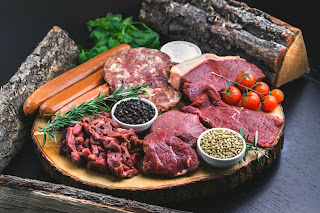What does phosphorus do? The understanding nutrients series
Welcome to this month’s edition of the understanding nutrients series. I started this ongoing series to give you a better understanding of the essential nutrients we get from food. I’m almost near the end of this series, with 22 nutrients already covered. You can find all the nutrients I’ve already done here.
Let’s get into this month’s post, looking at the mineral
phosphorus.
Roles of phosphorus:
Bones and teeth: phosphorus is crucial in the development of
your bones and teeth. It works with calcium to form hydroxyapatite which is the
main building block of bone and teeth. Most people know about the importance of
calcium for your bones, but calcium can’t work in isolation, phosphorus is
needed too. It also helps to rebuild you tooth enamel and so protect from
decay.
DNA and RNA: DNA and RNA are complex molecules made up of
multiple units. These singular units are called nucleotides, and multiple
nucleotides join together with chemical bonds to form a DNA or RNA strand.
Phosphate is needed to form these bonds, and so form DNA/RNA.
Energy: phosphate plays an essential role in energy
production and us using the energy from food we eat. The energy currency of our
cells is called ATP, or adenosine triphosphate. Without getting too detailed in
biochemistry, triphosphate means there’s 3 phosphates in the molecule. And each time ATP is
broken down and a phosphate is released, we get energy. So it's pretty important.
Cell structure: phosphate plays a role in the structure of
our cells, forming what's called a phospholipid bilayer. This phospholipid
bilayer forms the outer layer of our cells and control what goes in or out the
cell. This is very important for cellular communication.
Phosphorus also has roles in growth and development, muscle
contraction, and supporting various enzymes. It’s a very crucial mineral, so
how much of it do we need?
How much phosphorus do we need?
Adults need 540mg of phosphorus a day, with an additional
425mg a day if you’re lactating.
For reference 100ml of whole cow's milk has 91mg.
Phosphate from animal products is better absorbed than those
from plants. This is because the form of phosphate in plants is normally
phytate, which we can’t digest. Phosphate found in food additives is absorbed
better than whole food sources as these are water soluble so easier to dissolve. An example of a phosphate additive is sodium triphosphate which is
found in products like ham slices to retain moisture.
What foods are sources of phosphorus:
Animal products like meat and dairy are great sources of
phosphate. Legumes, wholegrains, and nuts also contain phosphorus, so this
isn’t an exhaustive list, but to give you an idea.
- 100g of sliced beef has 320mg.
- 100g of chicken breast has 270mg.
- 25g of cheddar cheese has 125mg.
- 2 boiled eggs have 205mg.
- 25g of almonds has 120mg.
- 100g of cous cous has 129mg.
- 100g of red lentils 107mg.
- 100g of boiled brown rice is 125mg.
- 250ml of hot chocolate made with milk has 260mg.
What happens if we don’t get enough phosphorus?
A lack of phosphorus in your blood
is called hypophosphatemia. It’s not common but can occur if you have a very poor
diet, or other medical conditions such as alcoholism. It can lead to a loss
of appetite, weaker bones, irritability, weakness, and fatigue.
It’s treated with tablets or an IV
infusion.
Key points:
- Phosphate is an essential mineral. It has roles in energy production, cell structure, and bone health.
- Adults need 540mg of phosphorus a day, and it’s better absorbed from animal sources or food additives.
- Meat, dairy, processed foods, beans, and lentils are all sources of phosphorus.
- A deficiency in phosphorus can lead to symptoms like weak bones, fatigue, and loss of appetite.
I hope you enjoyed this blog post.
Bye for now 👋
References:
Phospholipid bilayer: https://www.ncbi.nlm.nih.gov/books/NBK26871/
https://www.ncbi.nlm.nih.gov/pmc/articles/PMC5318242/
https://ods.od.nih.gov/factsheets/Phosphorus-HealthProfessional/
.jpg)



.jpg)

Comments
Post a Comment